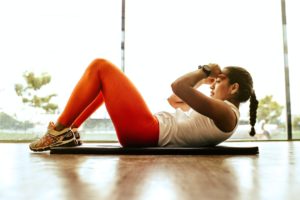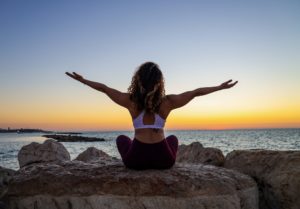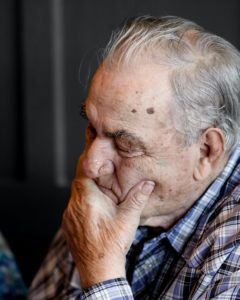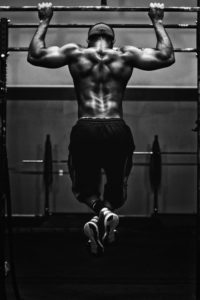With Movement – It’s a wrap!
I hope by now that with the small changes we’ve been making over the past couple of months, you’re feeling better than you were before we started! We are going to wrap up our 4 Small Steps For Big Health Change series with part 4, Movement & Meditation.
Movement
When we talk about movement, this doesn’t necessarily mean exercise. While planned and intentional movement (exercise), is something we all should strive for in our lives, for our intents and purposes, I just want to focus on making sure we’re not just sitting at our desks, staring at screens and completely forgetting that our bodies are suffering.
If you aren’t moving your body intentionally throughout the day, I encourage you to take what you learn and implement it along with the the other topics we’ve covered (water, sugar, & sleep). This is the icing on the cake! These are the small things we can do to make big differences in our lives. The foundational skills that we’ve navigated will allow us to build and continue to move toward being a healthier, happier and more emotionally agile human. If you’re looking for more detailed guides and tips on how to integrate movement into your daily routine, check out Thunder Fitness, a fantastic resource for all things related to fitness and health.
 Movement & Our Brain
Movement & Our Brain
Understanding how movement benefits our brain is just as important as understanding how it benefits our bodies. So let’s focus on how moving our bodies helps to improve cerebrovascular health and what that means (physically and emotionally).
If you do a quick google scholar search, you’ll find that there are multiple studies supporting the idea that exercise improves brain function, structure and connectivity. When these types of changes happen (in either direction) there are noticeable changes in learning, memory and cognitive function. Awesome, right?! When we allow an environment for such changes, we can be quicker to respond appropriately and better at grasping new content allowing us to move more efficiently through life.
The Emotional Side
Feeding off our ability to just function better, our emotional health is impacted in a huge way! Including movement and exercise as a regular part of your life has been shown many times to be an effective treatment for depression, anxiety, insomnia, ADHD and many more psychological struggles. There are very few people that I know that don’t struggle here to some extent. The research is complex, but in a very general way –
Improving vascular health improves blood flows
↓
Better blood flow increases oxygen and nutrient delivery
↓
Proper delivery of oxygen and nutrients can reduce inflammation and a stress response
↓
Add all of this to the physical changes in the brain, and wow – you can see how we’d be feeling better!
 Movement’s Impact on Dementia
Movement’s Impact on Dementia
Let’s also think longer term. “Exercise is also strongly associated with a reduced risk of dementia late in life. People who exercise regularly in middle age are one-third as likely to get Alzheimer’s disease in their 70s as those who did not exercise. Even people who begin exercising in their 60s have their risk reduced by half.” (Read article here). Given that more than 6 million Americans are living with Alzheimer’s right now, and that number is projected to rise to a staggering 13 million by 2050, if movement and exercise can help at all, I’d say it’s worth the effort.
In case that’s not convincing enough, realize this;
- In the US, dementia deaths have increased 16% during the Covid 19 Pandemic
- It kills more people than breast and prostate cancer combined
- Between 2000 and 2019, deaths from Alzheimer’s increased by 145%
Read more stats here.
Cardiovascular Disease
Did you know that As many as 250,000 deaths per year in the United States are attributable to a lack of regular physical activity?!
A lot of these deaths are a result of cardiovascular disease. The 5 major risk factors for CV disease are;
- A sedentary lifestyle
- High blood pressure
- Abnormal values for blood lipids
- Smoking
- and obesity
So, how does movement/exercise help? Well, exercise…
- Promotes weight reduction
- Helps reduce blood pressure.
- Reduces “bad” cholesterol levels in the blood (the low-density lipoprotein [LDL]),
- Reduces total cholesterol,
- Raises the “good” cholesterol (the high-density lipoprotein level [HDL])
- Favorably affects the body’s ability to use insulin to control glucose levels in the blood.
- Allows for increased vasodilation (arteries expanding), which in turn improves oxygen and nutrient delivery. Also, better movement allows “sticky” stuff from poor dietary choices to move along, rather than sticking to our arterial walls.

I know this information was very technical, but understanding what is happening inside is important when you’re at a crossroads with a decision that will impact your health – either for the better or to your body’s detriment.
Think about your heart and your arteries. The poor health of those are the leading cause of death in the US! Add other comorbidities and the quality of our lives will be diminished. Our total lifespan will be, too.
Aerobic Exercise Benefits
Aerobic exercise is key for your head, just as it is for your heart, and while the thought of exercising may stress you out (it’s hard, finding time, the soreness that may come), I assure you, the first steps are the hardest.
In the beginning, exercise will be more work than fun. But as you get into shape, you’ll begin to tolerate exercise, then enjoy it, and finally depend on it (I certainly do!).
Regular aerobic exercise will bring remarkable changes to your body, your metabolism, your heart, and your spirits. It has a unique capacity to…
- exhilarate and relax
- provide stimulation and calm
- to counter depression and dissipate stress.
It’s a common experience among endurance athletes and has been verified in clinical trials that have successfully used exercise to treat anxiety disorders and clinical depression. If athletes and patients can derive psychological benefits from exercise, so can you!
 Movement’s Impact on Mental Health
Movement’s Impact on Mental Health
How can exercise help with anxiety and depression? There are several explanations, some chemical, others behavioral.
The mental benefits of aerobic exercise have a neurochemical basis.
- Exercise reduces levels of the body’s stress hormones (adrenaline & cortisol).
- It also stimulates the production of endorphins, chemicals in the brain that are the body’s natural painkillers and mood elevators.
Behavioral factors also contribute to the emotional benefits of exercise.
- As your waistline shrinks and your strength and stamina increase, your self-image will improve.
- You’ll earn a sense of mastery and control, of pride and self-confidence.
- Your renewed vigor and energy will help you succeed in many tasks.
- The discipline of regular exercise will help you achieve other important lifestyle goals.
The bottom line is, as a preventative measure, and as treatment, movement and exercise have been shown over and over again to have a positive impact on stress and mood disorders. Feeling cranky and overwhelmed? Take 10 minutes and go for a walk, even jog or do some other form of exercise, and I guarantee, you’ll come back feeling better.
Bones!
For me, this topic is personal. If you’ve followed me for any length of time, you know I have a disease called “hypophosphatasia”. This disease is also known as “soft bones” disease. So, making sure I eat and move in a way that best takes care of my bones is VITAL on so many levels. For those of you without this disease, let’s focus on why movement and exercise are still just as important for you.
Getting enough exercise can help bones maintain strength that might otherwise be lost because of age- and hormone-related changes. Here are some types of exercise that help strengthen and maintain bone health.
- Weight-bearing exercises. These might include jogging, walking, dancing, stair climbing, or higher-impact sports, such as jumping, tennis, squash, or soccer. Even exercises such as tai chi and stair climbing have been shown to benefit bone health.
- Resistance exercises. Building muscle can also benefit your bones. Strong fibers of muscle actually pull on the bone when they contract, which nudges bone cells into action to help strengthen the bones. In addition, the stronger your muscles are, the more likely you will be able to maintain your balance and reduce your risk of falls, which are a major cause of fractures in older women.
- Stretching. Staying limber not only protects against falls, but can also help to ease pain associated with arthritis. Incorporate stretching exercises that target all your main muscle groups.
 Movement & Muscle
Movement & Muscle
Muscle and movement are immeasurably important to function, health, and quality of life. Check out these stats;
- Research has shown that sarcopenia (age-related muscle wasting) is responsible for a 3-8 percent muscle mass loss every decade after the age of 30!
- The effects of aging are compounded by lifestyle and neglect
- As few as two weeks of complete physical inactivity can have the same effect on muscle loss as a decade of aging!
Muscle plays many critical roles in overall health
How?
- It regulates body temperature and fluid flow
- It is vital to metabolic efficiency. Muscle is the metabolic powerhouse of the body
- Muscle provides a landscape of insulin receptors, energy storage, a depot of amino acids, and it is a secretor of cytokines (molecules that regulate immunity)
- Strong muscles increase spontaneous activity levels, decrease our reliance on others, and enable us to live longer, healthier, higher-quality lives
The importance of healthy muscle and quality movement cannot be overstated. Healthy muscle keeps us standing upright, drives our movement, and primes metabolic function. Movement is not just how we interact with the world; it lubricates the body and preserves muscle quality. Movement is standing up from a seated position, walking your dog, or picking up your child.
That’s a Wrap!

I realize that we all understand that exercise is important for our health. The science has long supported it, and the majority of us know that we need more of it. I really want you to see past the vanity aspect of it though. Movement and exercise change us for the better at a cellular level. Quality of life, disease risk, and auctionability are all greatly impacted when we incorporate some movement into our every day. If this isn’t yet a priority for you, what adjustments to your day can you make so that it is? Need help? Read about some easy ways to add exercise to your routine here.
If you’ve incorporated what we’ve learned over the past few months, you’ve done phenomenal things for your health! I hope that by focusing a little on your water & sugar intake, your sleep and movement, you’re feeling better than you were when we started.
Let’s Do The Work Together!
Hi! As a fitness and nutrition strategist, I work to help people take small steps toward lasting health change. These steps will be positively disruptive to your life and health! And the best part?! They won’t require you to completely shake up and change your day-to-day routine. Together, we will navigate your lifestyle, current health status, environment, and health/fitness goals to create steps to uniquely fit who you are. For a free, initial consultation, email me at [email protected]. I look forward to connecting with you!
~ Amanda

Interested in eating more healthy for life?
Listen to our friends over at Wellness Force Radio to learn about the “5 Must Have Nutrition Fundamentals”


 Movement & Our Brain
Movement & Our Brain Movement’s Impact on Dementia
Movement’s Impact on Dementia Movement’s Impact on Mental Health
Movement’s Impact on Mental Health Movement & Muscle
Movement & Muscle



 Stress and How to Deal with It
Stress and How to Deal with It